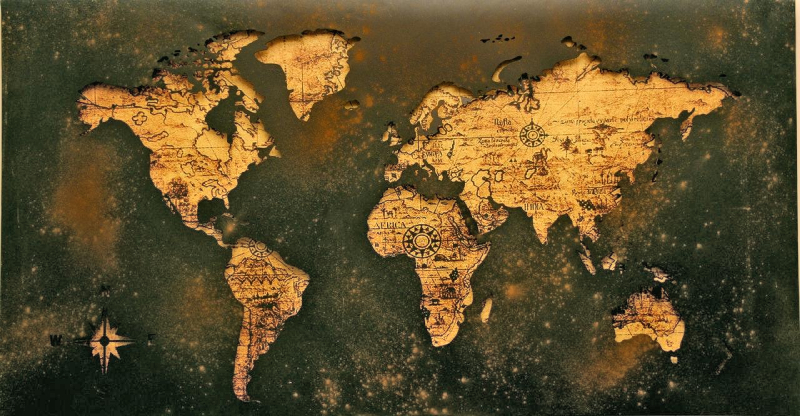GEOGRAPHY
ORIGIN OF EARTH- NEBULAR THEORY OF LAPLACE:
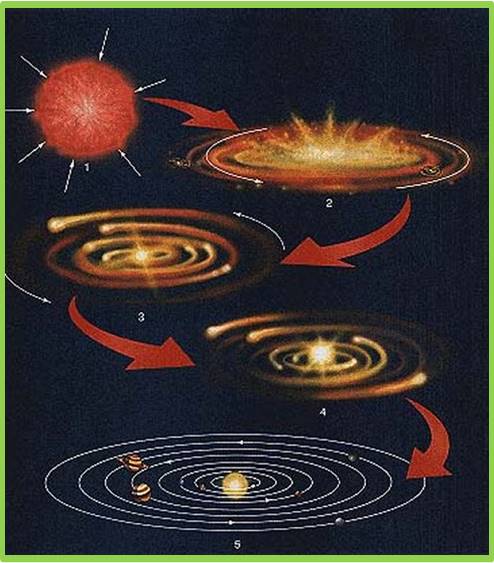
- Nebular theory was proposed by Pierre Simon de Laplace in 1796.
- According to this hypothesis, initially there was this nebula cloud which was made out of Helium, Hydrogen and dust particles. This nebula cloud start rotating very heavily and due to that most of the hydrogen and helium elements came to the center and started colliding with each other and due to the colliding and friction, fusion reaction took place and this created the sun the biggest star in the universe.
- When lighter elements like hydrogen and helium came to the center and heavier elements were went away from center which created the planets, and if we study our solar system we can see that the sun is made of lighter elements but planets are made out of heavier elements. Then these planets started forming small nebulas, and the further rotation, fiction and fusion created the disk shape cloud and planets were formed.
- When earth in its gaseous form was rotating at very fast speed and was compressed continuously. Then the heavy elements got deposited in its center and light elements got deposited on its outer surface. Thus we got heavier elements near the core and lighter at the surface.
STUDIES ON THE BASIS OF NEBULAR THEORY:
- Density Study: Geographer founds that earth’s surface density is 2-2.5 but the overall density of the earth is 5. This means that below the earth’s surface there are heavier elements as compared to the earth.
- Temperature Study: Geographer founds that as we move towards the depth of the earth, the temperature starts increasing. This supports the theory that gaseous form of earth got cooled at the surface but it is still hot at the core which is due to the residual energy.
- Structural Study: To find out what is at the interior of the earth, geographers decided to study types and composition of the rocks.
- Direct Evidences: They took the rocks from the deepest mines to study. They also took the volcanic rocks for study. But these evidences have some limitations that the depth of the mines and the volcanoes are limited to 100 km.
- Indirect Evidences: To find the properties of the rocks beyond the 100 km they studied the sample of the rocks from moon, mars, meteorites and they compared the rocks having the common elements.
CRITICISM:
- Nebular hypothesis theory does not explain the sources of origin of the nebula.
- It was not able to explain the sources of heat and motion of the nebula.
- As per the nebula hypothesis, the nebula is the gaseous state so the planet should also be in gaseous form, but the same is not true, planets are not in the gaseous state.
- The theory is not able to explain how gaseous nebula leads to the formation of solid planets.
- All the planets and satellites should rotate in the same direction as nebula rotate but the same is not true. As we know that all planets in our solar system rotate anti-clockwise except Venus and Uranus.
EDUARD SUESS THEORY:
Eduard Suess divides the Earth’s Interior into three parts:
- Barysphere: This is the core or the central region of the earth. The rocks of this layer are composed of Iron and Nickel. This layer was termed as NIFE (NI + FE = Nickel + Iron).
- Pyrosphere: This is the middle layer which surrounds the core on all the sides. The rocks of this layer are composed of Silicon and Magnesium. This layer was termed as SIMA (SI + MA = Silicon + Magnesium).
- Lithosphere: This is an outer layer which surrounds the SIMA. It is composed of Silicon and Aluminum. This layer was termed as SIAL (SI + AL = Silicon + Aluminum).
SEISMIC WAVE STUDY:
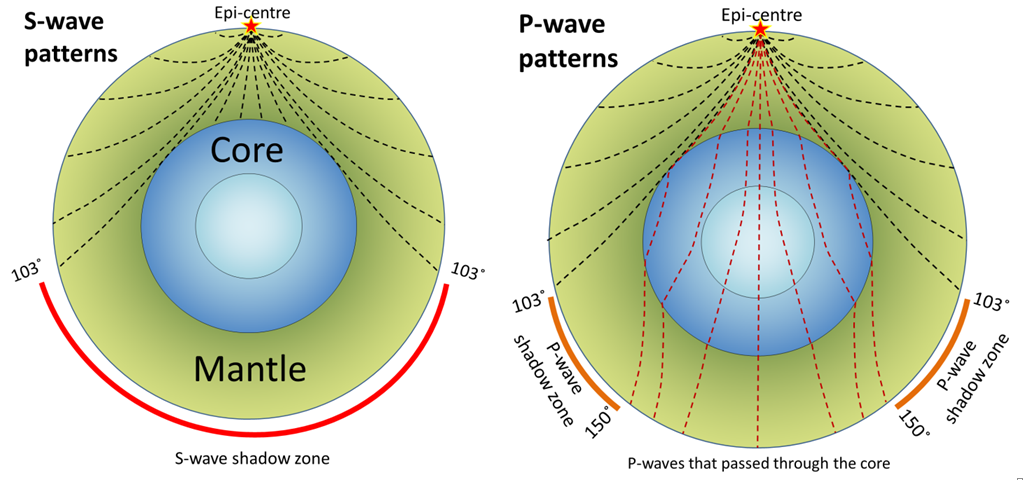
- The structure of the earth’s deep interior cannot be studied directly. But geologists use seismic waves to determine the depths of layers of molten and semi-molten material within the earth.
- Seismic waves are the mechanical waves which require medium for propagation. Their behavior changes with change of medium.
- 2 important seismic waves are Primary wave (P wave) and Secondary wave (S wave).
- P waves are the fastest, traveling about 6 to 7 kilometers per second. P-waves travel through solids, liquids, and gases. P-waves bend slightly when they travel from one layer into another. Seismic waves move faster through denser or more rigid material, thus its speed is highest in solid and lowest in gas.
- S-waves (secondary waves) are about half as fast as P-waves, traveling at about 3.5 km (2 miles) per second. S-waves only move through solids.
- Where seismic waves speed up or slow down, they refract, changing the direction in which they are traveling. Where seismic waves encounter an abrupt boundary between two very different layers, some of the seismic wave energy is reflected, bouncing back at the same angle it struck. The reflections and refractions of seismic waves allow the layers and boundaries within the earth to be located and studied.
By tracking seismic waves, scientists have learned what makes up the planets interior:
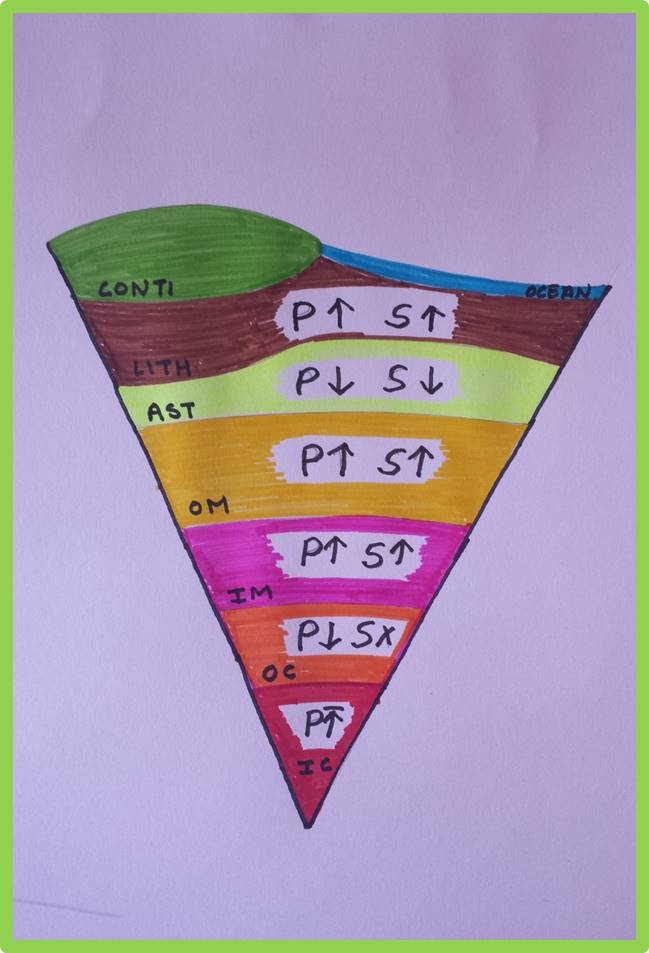
- The thickness of the crust. This is a measure of the thickness of the crust based on the abrupt increase in speed of seismic waves that occurs when they enter the mantle. (P increases, S increases).
- The thickness of the lithosphere. Where seismic waves pass down from the lithosphere into the asthenosphere, they slow down. This is because of the lower rigidity and compressibility of the rocks in the layer below the lithosphere. (P decreases, S decreases).
- The boundary between the upper and lower mesosphere (upper and lower mantle). This shows up as an increase in seismic wave speed at a depth of 660 km. (P increases, S increases).
- The boundary between the mantle and the core (Outer core). This is marked by S-waves coming to an abrupt stop, presumably because the outer core is liquid, and a sudden large reduction in the speed of P-waves, as they enter the liquid core where there is no rigidity to contribute to P-wave speed. (P decreases, S stops).
- The inner core. This was first recognized by refraction of P-waves passing through this part of the core, due to an abrupt increase in their speed, which was not shown by P-waves traveling through only the outer part of the core. This concludes that inner core is solid. (P increases).
COMPOSTION OF THE INTERIOR OF EARTH:
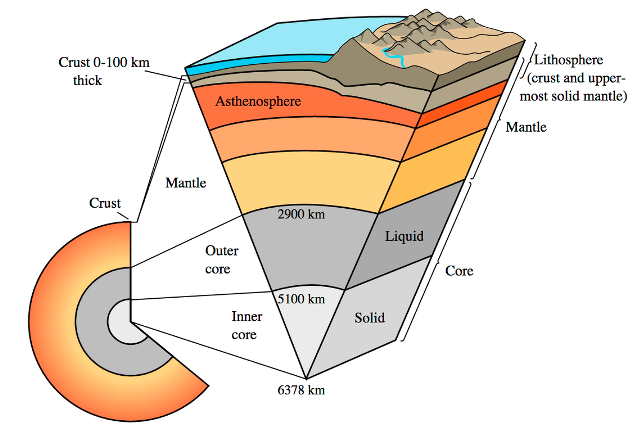
EARTH AS A WHOLE
- Iron
- Oxygen
- Silicon
- Magnesium
- Sulfur
- Nickel
- Calcium
- Aluminum
EARTH’S CRUST
- Oxygen
- Silicon
- Aluminum
- Iron
- Calcium
- Magnesium
- Sodium
- Potassium
TYPES OF ROCKS
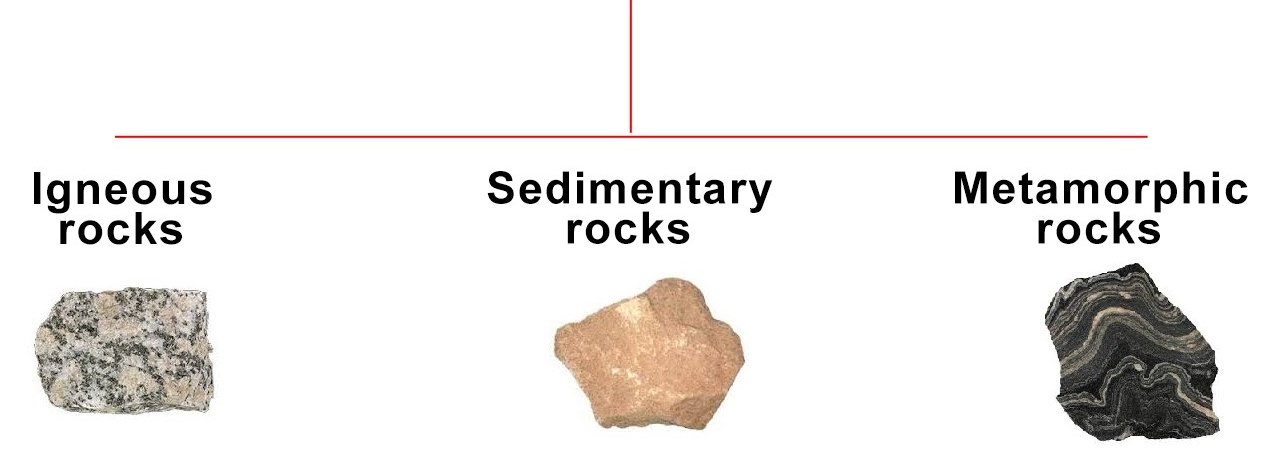
- Igneous Rocks- solidified from magma and lava.
- Metamorphic Rocks- formed out of existing rocks undergoing recrystallization
- Sedimentary Rocks- the result of deposition of fragments of rocks.
IGNEOUS ROCKS
- Igneous rock forms when magma cools and makes crystals. Magma is a hot liquid made of melted minerals. The minerals can form crystals when they cool.
- They don’t have strata or layers. Because entire lava is solidified
- They are crystalline.
- They don’t have fossils.
- When they are formed inside of the earth, they are called intrusive, or plutonic, igneous rocks. If they are formed outside or on top of Earth’s crust, they are called extrusive, or volcanic, igneous rocks.
- Granite and diorite are examples of common intrusive rocks.
- Pumice is the example of common extrusive rocks.
METAMORPHIC ROCKS
- Metamorphic rocks are rocks that have been changed from their original form by immense heat or pressure.
- Both igneous and sedimentary rocks changed under heat or pressure or both.
- No fossil.
- No stratification.
- Metamorphic rocks have two classes: foliated and non-foliated.
- When a rock with flat or elongated minerals is put under immense pressure, the minerals line up in layers, creating foliation.
- Non-foliated rocks are formed the same way, but they do not contain the minerals that tend to line up under pressure and thus do not have the layered appearance of foliated rocks.
- Examples of metamorphic rocks
| Granite | Gneiss |
| Limestone | Marble |
| Sandstone | Quartzite |
| Clay/Mudstone | Slate/Schist |
SEDIMENTARY ROCKS
- Sedimentary rocks are formed from pieces of other existing rock or organic
- Always stratified.
- They may have fossils.
- There are three different types of sedimentary rocks: clastic, organic (biological), and chemical.
- Clastic sedimentary rocks, like sandstone, form from clasts, or pieces of other rock.
- Organic sedimentary rocks, like coal, form from hard, biological materials like plants, shells, and bones that are compressed into rock.
- Chemical sedimentary rocks, like limestone, halite, and flint, form from chemical precipitation.
ROCK CYCLE:
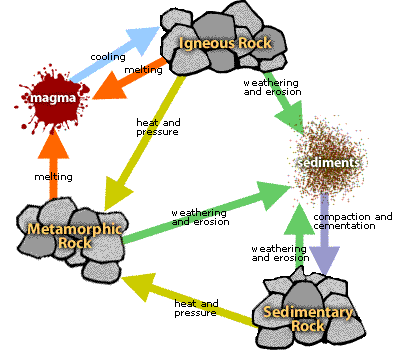
- The Rock Cycle is a group of changes. Igneous rock can change into sedimentary rock or into metamorphic rock. Sedimentary rock can change into metamorphic rock or into igneous rock. Metamorphic rock can change into igneous or sedimentary rock.
- The rock cycle continues. Mountains made of metamorphic rocks can be broken up and washed away by streams. New sediments from these mountains can make new sedimentary rock.
